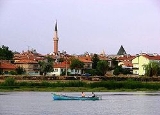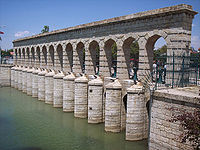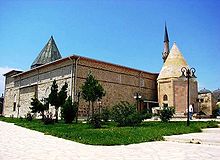
Beysehir
Encyclopedia

Konya Province
Konya Province is a province of Turkey located in central Anatolia. The provincial capital is the city of Konya. It is the largest province by area of Turkey.-Districts:...
in the Central Anatolia region of Turkey
Turkey
Turkey , known officially as the Republic of Turkey , is a Eurasian country located in Western Asia and in East Thrace in Southeastern Europe...
. The town is located on the southeastern shore of Lake Beyşehir
Lake Beysehir
Lake Beyşehir is a large freshwater lake in Isparta and Konya provinces, southwestern part of Turkey. It is located at around . It has an area of 650.00 km² and is 45 km long and 20 km wide. It carries the same name as the principal urban center of its region, Beyşehir.Water level...
and is marked to the west and the southwest by the steep lines and forests of the Taurus Mountains
Taurus Mountains
Taurus Mountains are a mountain complex in southern Turkey, dividing the Mediterranean coastal region of southern Turkey from the central Anatolian Plateau. The system extends along a curve from Lake Eğirdir in the west to the upper reaches of the Euphrates and Tigris rivers in the east...
, while a fertile plain, an extension of the lake area, extends in the southeastern direction. According to 2000 census, population of the district is 118,144 of which 41,312 live in the town of Beyşehir.
History

Hittites
The Hittites were a Bronze Age people of Anatolia.They established a kingdom centered at Hattusa in north-central Anatolia c. the 18th century BC. The Hittite empire reached its height c...
monument situated in Beyşehir's depending locality of Eflatunpınar
Eflatunpinar
Eflatun Pınar is the name given to a spring which rises up from the ground, creating an oasis and fountain. The spring lies 80 miles west of Konya, and drains into Lake Beyşehir in Anatolian peninsula at ancient Pisidia region. In ancient times a small temple was built here to honor one of the...
, at a short distance to the northeast from the town, proves that the Hittite Empire had reached as far as the region, marking in fact, in the light of present knowledge, the limits of their extension to the southwest. Evidence points out that an earlier settlement, perhaps dating back to the Neolithic Age, was also located in Eflatunpınar. Another important early settlement was located in Erbaba Höyük, situated 10 km (6 mi) to the southwest of Beyşehir, and which was explored by the Canadian
Canada
Canada is a North American country consisting of ten provinces and three territories. Located in the northern part of the continent, it extends from the Atlantic Ocean in the east to the Pacific Ocean in the west, and northward into the Arctic Ocean...
archaeologists Jacques and Louise Alpes Bordaz in the 1970s, leading to precious finds along four different settlement layers.
Beyşehir region corresponds to classical antiquity's Pisidia
Pisidia
Pisidia was a region of ancient Asia Minor located north of Lycia, and bordering Caria, Lydia, Phrygia and Pamphylia. It corresponds roughly to the modern-day province of Antalya in Turkey...
. At the location of the town itself, there was in all likelihood an ancient city, probably named Karallia, which was one of the two urban centers that surrounded the lake at the time. The same center would have been re-named in Byzantine
Byzantine Empire
The Byzantine Empire was the Eastern Roman Empire during the periods of Late Antiquity and the Middle Ages, centred on the capital of Constantinople. Known simply as the Roman Empire or Romania to its inhabitants and neighbours, the Empire was the direct continuation of the Ancient Roman State...
times.
The ancient city's state of desolation in the first decades of the 13th century is suggested by the name "Viranşehir" that the Seljuk Turks had given to the town, meaning "the desolate city". The Seljuk Sultans of Rum based in Konya
Konya
Konya is a city in the Central Anatolia Region of Turkey. The metropolitan area in the entire Konya Province had a population of 1,036,027 as of 2010, making the city seventh most populous in Turkey.-Etymology:...
nevertheless built their summer residence nearby, in an agglomeration situated on the southwestern lake shore at a distance of 80 km (50 mi) from Beyşehir city, and which came to be known as Kubadabad Palace
Kubadabad Palace
Kubadabad Palace or Kubad Abad Palace refers to a complex of summer residences built for the sultan and his court during the reign of the sultan of the Sultanate of Rum Kayqubad I...
. While the most precious finds of Kubadabad site date from the reign of Alaeddin Keykubad (1220-1237), it was a seasonal settlement area chosen by and for the sultans already in the late 12th century.
After the fall of the Seljuks, Viranşehir was re-named for a time as Süleymanşehir in honor of one of the Bey
Bey
Bey is a title for chieftain, traditionally applied to the leaders of small tribal groups. Accoding to some sources, the word "Bey" is of Turkish language In historical accounts, many Turkish, other Turkic and Persian leaders are titled Bey, Beg, Bek, Bay, Baig or Beigh. They are all the same word...
s of the region's ruling dynasty, the Eshrefids, who made the town into his capital. Since the beys of Eshrefids resided here, the present name of Beyşehir was gradually adopted for the town. The Great Mosque of Beyşehir built by the dynasty between 1296-1299, also called Eşrefoğlu Mosque, is considered one of the masterpieces of the intermediate period of Anatolian beyliks between the Seljuk and Ottoman architecture styles.

